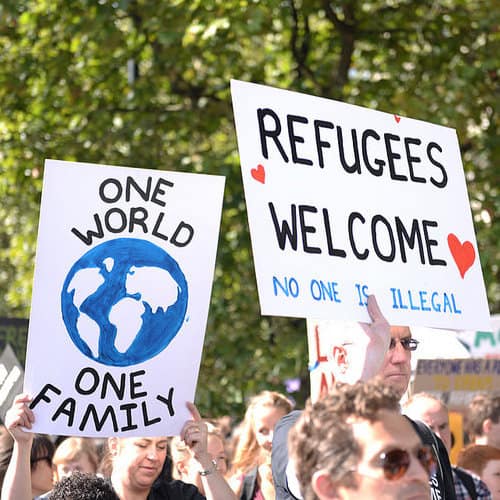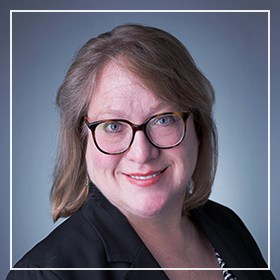Since the refugee crisis of 2015, vernacular humanitarianism—locally focused, volunteer-led efforts at humanitarian action—has been put forward as the answer to the inability of the institution-led international humanitarian system to meet the needs of people fleeing conflict. From Techfugees, a group made up of young tech-sector professionals offering IT-driven solutions to refugees’ problems to the Dirty Girls of Lesvos, who washed the clothes of refugees who had made the trip across the sea to Greece, to the individuals across Europe who lined up to offer refugees food, clothing and diapers, volunteers seemed to be the answer to both the financial shortfall and the organizational rigor mortis that has set in at the UN and international NGOs. But can new, digitally mediated forms of social organization remedy the problems in the international system? What motivates the volunteers in these small-scale organizations? What constraints do the loose forms of these organizations pose?
How does vernacular humanitarianism invoke both volunteers and recipients as subjects, and how does that affect aid?
Since 2015, I have been a volunteer in a small humanitarian organization, the Bloomington Refugee Support Network (BRSN), a local organization in Indiana, USA, focused on helping refugees resettle in our small town. In the US, all refugees are resettled by resettlement agencies which, although they are NGOs, must be authorized by the US Department of State. BRSN, a newly formed group, was approached in early 2016 by Exodus Refugee Immigration, an Indianapolis-based resettlement agency that wanted help in gaining State Department permission to open Bloomington as a resettlement site. As word spread that refugees might come to Bloomington, the group quickly blossomed from a handful of people to a complex organization of over 400 people organized into an executive board and 16 different subcommittees. Yet, a year later, the group was moribund—not a single refugee had been helped, despite many meetings of the group and its sub-groups. Here, I argue that like many volunteer-led organizations, the BRSN suffered from three dilemmas: (1) the conflict between refugees’ needs and volunteers’ needs, (2) the ways American class status intersected with the humanitarian impulse, and (3) the vulnerability that small humanitarian organizations have to political hijacking.
It seems curious to think of volunteers focused on helping others as themselves needy. Yet, many people volunteer precisely because they are in need—in need of activity, a sense of themselves as being connected to a larger world, and a temporary reprieve from loneliness (Malkki 2015). Vernacular humanitarianism is a “self-humanizing” practice, one in which volunteers constitute themselves as ethical and socially connected persons (Malkki 2015:261-2). In that sense, vernacular humanitarianism is a deeply self-focused practice centered on givers, not on the recipients of aid, who remain nothing more than shadowy projections of the volunteers’ imaginations. This was also true at the BRSN, where the group’s leaders were intently focused on organizational structure and on holding public meetings, but much less on who the refugees were, what had driven them out of their homes, or what their experiences prior to resettlement were. While BRSN members engaged in lots of “imaginative projection” (to use Malkki’s term) about their own interactions with refugees, they engaged in much less imaginative projection about the refugees themselves, mostly lumping them all together into an abstract figure labelled “the refugees,” (even though refugees from, say, Syria were much different from those from the Democratic Republic of the Congo) and asking few questions about their histories. Few people in the BRSN thought in depth about refugees as active subjects, who might have goals or preferences of their own. Rather, they were conceptualized almost solely in terms of their potential relationship to volunteers. One woman, for example, contacted me repeatedly about offering piano lessons to “the refugees,” despite the fact that music lessons were not part of what Exodus asked the BRSN to provide; others expressed intense desires to host refugees in their homes, despite being told that the US government and Exodus would set them up in apartments.
For many potential volunteers, what they wanted was contact with refugees, and what they imagined was not their donations circulating, but themselves in immediate relation to refugees as givers.
Some of BRSN’s volunteers focused less on their potential relationships with refugees, and more intently on their own connection to the community, much of which revolved around the performance of class status. Unlike Malkki’s volunteers, who were elderly women were knitting ‘aid bunnies’ and ‘trauma teddies,’ most of the BRSN’s volunteers were either retired or active professionals who wanted to establish themselves as people whose skills in organizational practice made them (still) valuable as community leaders. Some volunteers focused on their skills at institution-building: for one member of the executive board, for example, the fact that the organization had grown at such an astounding pace that volunteers now outnumbered potential refugee arrivals by a factor of more than 7 to 1 was a symbol of her skill at organizing, rather than posing a significant management problem. Others focused on their own skills at database management, information technology, and at reading accounts and financial reports. (One volunteer even went so far as to accuse Exodus of financial malfeasance for not providing what he deemed proper financial reporting to donors). Some, mostly men, had no particular expertise but held forth at great length during meetings, interrupting others to offer their opinions and “mansplain” to the president and the executive board members, many of whom were middle-aged women. More than simply trying to establish themselves as ethical people or as human beings in connection with others, as Malkki’s volunteers did, much of what happened at the BRSN’s meetings was about volunteers experiencing the tenuousness of their own class status and establishing themselves as middle-class professionals, as people who had expertise and who were worth listening to.

One effect of the helpers’ drive to meet their own needs was that that all the help they would offer had to be local. Most of the world’s refugees, of course, were far away: in Lebanon or Turkey or Greece or Kenya. Despite the efforts of a volunteer to re-orient the group towards helping refugees in a school in Istanbul, for example, the other volunteers showed little inclination to engage with distant suffering. The problem seemed to be a failure of imaginative projection: with no ability to see themselves in the picture of distant refugees, volunteers lost interest. Even Indianapolis, 90 km away, seemed too far. BRSN’s volunteers had little appetite for helping the refugees Exodus was resettling there. Related to this was volunteers’ general unwillingness to donate cash, the thing that both Exodus and the refugees themselves needed most. While volunteers were eager to donate time, used household goods and even living space in their own homes, raising cash proved to be much more difficult.
Volunteers rejected the insulating layer that money inserted between themselves and refugees, as well as the distance that cash enabled.
The issue of class came to the fore in a brutal and surprising fashion when the BRSN’s meetings were suddenly hijacked by members of Grassroots Conservatives, another local volunteer-based group affiliated with the Tea Party that came to share many of Donald Trump’s ideas during his presidential run. At a meeting at a local church, members of Grassroots Conservatives grabbed the microphone and began voicing objections to resettling refugees in Bloomington, particularly Syrian refugees. One woman asserted (falsely) that refugees were unvaccinated and would spread disease. A man wearing a “Jesus Loves You” t-shirt began shouting into the microphone, saying “I think most of us are unaware of Islam. Unfortunately, Islam is a religion of hate! Not only that, but they kill Christians and they kill Jews and it’s totally anti-Christ!” (Streetman 2016). When members of the BRSN tried to wrest the microphone away from him, he began taking swings at them. The meeting threatened to devolve into a fistfight: something that shocked the middle-class liberals of the BRSN but appeared to delight the Grassroots Conservatives, most of whom appeared to be working class people. From that moment on, the humanitarianism of the BRSN became deeply entangled with party politics and the US presidential election, and most members of the BRSN turned their attention and their imaginative projection away from refugees and towards the Grassroots Conservatives, whose bellicosity they struggled to understand. Soon, the goal of the organization appeared to have shifted from helping refugees to engaging in a public political battle.
Vernacular humanitarianism, despite its self-representation as politically neutral, was intrinsically bound up in local context, which made it vulnerable to being hijacked for political ends and gave it a startling fragility.
In the end, no refugees ever came to Bloomington. Once elected, Donald Trump made good on his promises to supporters like the Grassroots Conservatives, and lowered the cap on by over 50%, from the 110,000 planned by the Obama administration, to only 50,000. With so few refugees being admitted (and almost none during the 120-day moratorium imposed by the Trump administration’s travel ban), Exodus did not need to open another resettlement site. But the BRSN remained active, searching for refugees or asylum seekers to aid with donated clothing and household supplies, free housing in people’s homes, legal help and more. There remained far more helpers than people in need of help: what most refugees or asylum seekers said they needed most–cash–was often at odds with what volunteers were willing to provide.
Much of the critique of humanitarianism has been leveled at large humanitarian organizations trapped in their own bureaucracies. Vernacular humanitarianism, with its person-to-person connections, promises to reject the corporatization of aid delivery, cut overhead costs and improve efficiency in aid delivery. Where bureaucratized humanitarianism claims to have submerged altruism in the service of Weberian rationalization, vernacular humanitarianism promises to put empathy and heart back in the aid process. But as the experience of the BRSN shows, vernacular humanitarianism is often held hostage to the emotional and social needs of its donors, leaving aid delivery uneven and unstable in both space and time. Tightly bound to its social context, vernacular humanitarianism often leaves recipients as abstract and obscure figures abstracted from the real political and historical contexts that displaced them, and thus inadvertently reinforces the othering that characterizes anti-immigrant rhetoric (Malkki 1996). If the problem with institutional humanitarianism is that it operates through a chaotic and improvised “adhocracy” rather than the rationalized bureaucracy it claims to have (Dunn 2012), vernacular humanitarianism offers no remedy.
Rather than being free from the constraints of organizational rules and therefore more nimble and more efficient, vernacular humanitarianism has its own forms of adhocracy and chaos that disrupt it as well.
Sadly, for all its promise, humanitarianism outside the organizational structures of the international system seems unlikely to replace its institutional counterpart.
References:
Dunn, Elizabeth Cullen. “The Chaos of Humanitarianism: Adhocracy in the Republic of Georgia” Humanity 3(1):1-23.
Malkki, Liisa. 1996. “Speechless Emissaries: Refugees, Humanitarianism, and Dehistoricization.” Cultural Anthropology 11(3):377-404.
________. 2015. The Need to Help: The Domestic Arts of International Humanitarianism. Durham, NC: Duke University Press.
Streetman, Jonathan. 2016. “Conversation Grows Heated at Refugee Forum.” Bloomington Herald Times, August 25.
Featured image by Ilias Bartolini (flickr, CC BY-SA 2.0)





